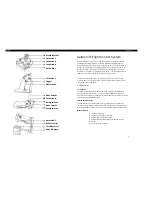
Power Management
BCM5718 Programmer’s Guide
Broadcom
®
January 29, 2016 • 5718-PG108-R
Page 188
If a PCI device supports Expansion ROM, the BIOS will assign a Expansion Base address to the device. It then
checks for a valid ROM header (0x55 0xAA as first two bytes, and so forth) and checksum. If the ROM header
and image are valid, the BIOS will copy the Expansion ROM image to HOST’s Upper Memory Block (UMB) and
invoke the initializing entry point.
Preboot Execution Environment
Preboot Execution Environment (PXE) is implemented as an Expansion ROM in the NIC implementation. In the
LOM implementation, PXE normally resides in the system BIOS. In the NIC implementation, PXE image is
stored in the NVRAM. Upon power on reset of the Ethernet controller, the RX RISC will load the boot code from
the NVRAM into RX RISC scratch pad and execute. This boot code will program the device with programmable
manufacturing information (such as MAC address, PCI vendor ID/device ID, etc.). If PXE is enabled, the boot
code responds to the Expansion ROM accesses of system BIOS.
Boot code is executed when the Ethernet controller is reset via PCI Reset or S/W device reset. PXE initialization
should only be necessary after a PCI reset. The boot code differentiates PCI Reset and driver initiated software
reset by checking content in Internal Memory at 0xb50. If the content is 0x4B657654, then the reset is due to
driver initiated software reset. Therefore, the device driver has to initialize 0xb50 with 0x4B657654 before
issuing a S/W device reset.
Power Management
Description
The Ethernet controller is compliant with the PCI v2.0 (PCI v2.1 for BCM5719) power management
specification. The MAC is programmable to two ACPI states: D0 and D3. The D0 state is a full power, operational
mode—all the MAC core functions run at the highest clocking frequency, and components are fully functional.
The MAC may be either initialized or uninitialized in the D0 ACPI state. An uninitialized D0 state is entered
through a device reset or PME event; the MAC functional blocks are not started and initialized. Host software
must reset/initialize hardware blocks to transition the device to a D0 initialized (active) state. The D0 active state
places the device into a full power/operational mode. Receive and transmit data paths are fully operational, and
the PCI block is initialized for bus mastering DMA.
Host device drivers do not differentiate between D3 hot and D3 cold states. ACPI-compliant device drivers are
unloaded and quiescent in the D3 state and PCI slot power state is transparent. When the MAC is in D3 hot
state, PCI slot power (3.3V or 5.0V) is available to power the PCI I/O pins. The PCI configuration and memory
space may be accessed in D3 hot state. The core clock must remain enabled, so the MAC can respond to PCI
configuration and memory transactions. The Disable_Core_Clock bit, in the PCI Clock Control register enables/
disables clocking in the core clock domain. A D3 cold state provides only the PCI Vaux supply—PCI slot power
is not present. The MAC will consume a maximum of 375 mA in a D3 cold power management mode.
The following functional blocks are integral to MAC power management:
• PMSCR register
• PCI Clock Control register
• Miscellaneous Control register
















































